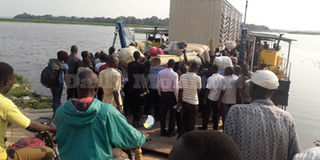Prime
Leaders pour cold water on Obongi ferry relocation plan

Passengers board the ferry from Obongi to Sinyanya landing site in July 2019. PHOTO/MARKO TAIBOT
What you need to know:
- Some leaders say the decision to relocate the ferry was made without consulting them.
A proposal by Uganda National Roads Authority (Unra) to relocate Obongi-Sinyanya ferry docking site to Angaliacini-Liri has sparked controversy among authorities and communities in West Nile Sub-region.
In a July 9, 2020 letter to Obongi leaders, Ms Allen Kagina, the Unra executive director, revealed that operations of Obongi-Sinyanya ferry has been halted due to increasing water levels, which she said posed a threat to free navigation on the water.
However, after nine months of inactivity, Obongi leaders wrote to Unra asking them to send a team of experts who would study two alternative relocation sites of Angaliacini-Liri and Aliba-Offu.
This came after Unra informed the public that although Obongi was still the best site as it would enable the ferry make at least 11 trips daily, it had proved expensive to maintain.
Following an assessment between the two sites, the authority said they zeroed on Angaliacini-Liri site as the best alternative.
According to the assessment, the relocation of the ferry to the new site will take two months and will cost Shs200m.
Whereas Unra reportedly secured the funding to start the relocation, a section of the business community and leaders from Obongi District recently petitioned the authority protesting the move.
The petitioners claim that the relocation of the ferry to Angaliacini site was not unanimously agreed upon and that it would systematically sabotage economic progress in the district.
Mr Abusalim Omar, a resident of Obongi, on Wednesday said the current landing site is strategically located on a trade route connecting Arua City to Juba city and to the DR Congo.
Mr Omar urged Unra to find a permanent site for the ferry taking into consideration the previous incident of 1962 to 1964 and that of last year where the water levels went high.
“The planned relocation must be rejected. The resources they plan to use should be channeled to improving the current site instead of seeking temporary solutions,” he said.
He added: “The best thing Unra and our leaders should do is get a supplementary budget for upgrading the current site and the proposed budget (Shs200m) for the Angaliacini-Liri site should be used to get a speed boat to continue helping the people temporarily,” he added.
Mr Ben Anyama, the Adjumani District chairperson, said the leadership of Obongi should have consulted their counterparts before the petition since issues surrounding the ferry operations affect the entire sub-region.
“The ferry itself is a critical pillar of development here. If the technical engineers recommended having the ferry relocated then it has to be relocated so that it continues providing the service instead of being idle,” he said.
Mr Anyama said the high water levels at the Obongi site cannot allow the ferry to resume operations.
“Instead of fighting over relocation, civil and political leaders in the Madhi sub-region should unite and form a force to lobby for another ferry for Obongi-Sinyanya once the current one is relocated,” he said.
In a June 17 letter to the Obongi District chairperson, Mr John Ssejemba, the Unra acting director of road infrastructure protection, recommended that another engagement meeting be held to resolve the matter.
Dr George Bhoka Didi, the Obongi County MP, said relocating the ferry is a better idea since it is a national transport asset that the Ministry of Works and Transport cannot keep idle.
“Although a section of the affected communities is advocating for the upgrading of the old site, the ferry is a national transport asset which the ministry of works may not allow it to depreciate for the proposed two to five years to fix the current landing site,” Dr Bhoka said.
He added: “That matter is already before the jurisdiction of the leadership of Obongi district local government and its stakeholders to whom UNRA initially wrote. We do not know when the floods will recede, meaning, the matter has to be handled with sobriety.”
But Mr Abdul Twabu, a resident and businessman in Obongi Town council, argued that the alternative routes consume much time and the ferry takes few trips.
“I still don’t understand why the government should waste funds on a temporary route and again inject a lot of money on the original route just because of an emergency which can be solved once and for all,” Mr Twabu said.
Issue...Water levels
In Obongi District, water transport is the only means of mobility and access to basic services. Residents have to move to neighbouring districts of Adjumani or Moyo to seek services.
In 1962, on the eve of the country’s Independence Day, the Madhi area experienced rise in water levels that affected the transport system.
According to the Ministry of Works and Transport, the water transport system suffered a huge setback with the 1961 flooding.
Very high rainfall was recorded during the first six months of 1962 and as a result, the water levels of the lake rose by 2.5 m by 1964 .
Whereas the water levels (2.5m) remained high until 1964 when they eventually dropped, it is feared that the current level could last more than three years and affect navigation.
Due to the recent heavy rain in early 2020, by May last year the water level had exceeded the historical mark and hit 13.42 m.




